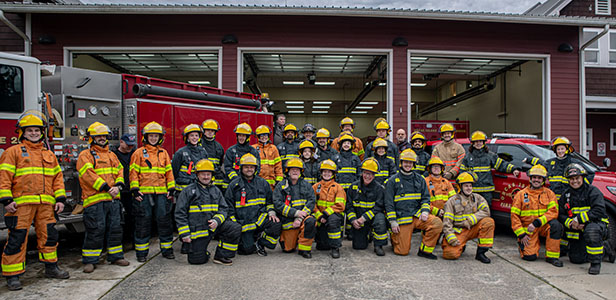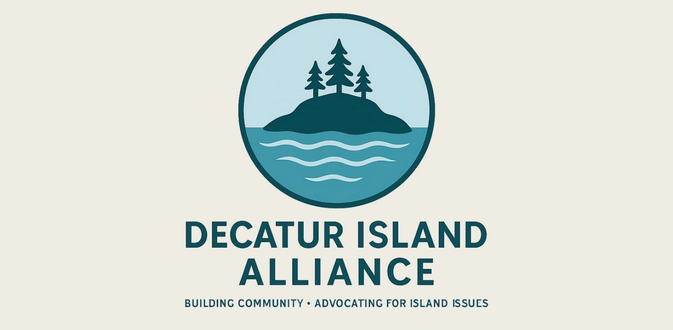At a Special Meeting of the Eastsound Planning Review Committee on Jan. 20, members took on area assignments, adopted a procedure for that meeting only, and formulated their comments to the review for the Craftsman Corner project, a conditional use permit for a third building to be constructed at Orcas Rental and Saw.
The Special Meeting was called in order to advise the Hearing Examiner’s Feb. 3 meeting on the Craftsman Corner matter, and to prepare for the County Council meeting on Orcas Island on Feb. 15.
Absent from the meeting was EPRC member Peg Manning; member Teri Williams recused herself from discussion and voting on EPRC comments on the Craftsman Corner review, as she had previously served as agent for Steve Pearson, Orcas Power and Saw owner.
The meeting began with the EPRC distinguishing between a draft procedural for reviewing all projects that come before the county advisory committee, and the conduct of the EPRC meetings in general.
EPRC member Teri Williams said “My job on the EPRC is to read the Eastsound Sub-area Plan and weigh applications for project review in light of that.”
County Senior Planner Colin Maycock circulated ordinances passed by the Council in 2008, dealing with the conduct of business of advisory committees. The group agreed unanimously that the protocol for Thursday’s Special Meeting would allow public comment on each agenda item in the open forum part of the meeting, and once the open forum was closed for committee deliberations, public comment would no longer be allowed; although that restriction could be waived by the committee chair.
EPRC Member Fred Klein spoke in favor of the template for project review drafted by EPRC Chair Gulliver Rankin, and commented that such a template “would be great for projects that come to the EPRC in a timely manner.”
However, Klein continued, because the Ocean Forest and Craftsman Corner development plans came to the EPRC after the projects were built, “We need to look at Craftsman Corner and Ocean Forest differently from normal review.”
Rankin suggested that the development template be created that incorporates the Eastsound Sub-area Plan; the template’s information would then be filed with the county at the beginning of the permitting process, and come back to the EPRC for review “with the factual information.”
Williams spoke to the plan review process saying that permit applicants are “counting on the County to identify noncompliance; I agree something has to happen, but not sure [the developmental template] fits in the process.
“Because the Eastsound Sub-area Plan is specific,” if the property owners read the Plan, then they “can be guided to land use restrictions in the Eastsound Sub-area,” Williams said. Rankin noted that the possibility for varying interpretation of the Sub-area Plan and other regulations “exists with every new planner in the county.”
EPRC member Rick Hughes said he was in favor of creating a checklist for moving forward: such a template would not be a legally binding document, but would help ”identify ruling documents.”
Maycock said that the Planning Department is “now actually developing a checklist for each activity center,” and suggested that this would be the “ideal situation for EPRC to use a mutually agreeable form with the county.”
Williams agreed to obtain the developing checklist for hamlet and activity center applications from the County Planning Department, and bring it back to the EPRC to review.
2011 Work plan:
The EPRC agreed to move forward the following elements of the 2010 Work Plan:
- the transportation – streetscape plan
- the Mount property stormwater treatment project
- the Critical Areas Ordinance update
- housing – compare the Eastsound with the county needs assessment
After some public discussion, they added the following items:
- review the “Nelson File” (a revised guidance document) and relate it to the Eastsound Sub-area Plan, moving development standards into the Uniform Development Code (UDC) Planning Docket: #17 .
- work with the county and the state on the Scenic Byways project
- signage issues
- formulate a process for implementing renewable energy
- consider the concept of “Transition Towns” that structure town plans with a view toward energy issues; and how such concepts may be applied to the Sub-area Plan
In further public comment of this agenda item, Port Manager Bea von Tobel suggested that the EPRC work with public utilities and port districts; Rick Hughes volunteered to take that task on.
The EPRC plans to present its 2011 Work Plan when it reports to the County Council on Orcas Island on Feb. 15; and to ask for help in implementation, in the form of county staff time. In a letter to the Planning Department, Rankin wrote:
I want to express to the Council our gratitude for the regular attendance of Senior Planner Colin Maycock, Councilmen Fralick and Knapp, and the willingness of staff from all departments to attend our meetings when requested. I appreciate that Pete Rose reviews our agendas and has remained engaged in our proceedings. As a result, the EPRC is better aligned with the county, able to successfully focus county resources, and provide timely advice to the County Council and Planning Commission on matters affecting Eastsound and its residents.
Sadie Bailey spoke in support of the public outreach component of the 2010 Work Plan and asked that the EPRC expand public outreach. In the course of the following discussion, it was brought out that many links on the county website (www.sanjuanco.com ) are “dead” or not updated.
Maycock spoke to the ongoing process of transferring documents from older websites, and providing links to the most recent version of documents. He is the EPRC “conduit” to add material from the committee to the website.
Bailey also spoke to the need for tree windbreaks in Eastsound, and suggested that the EPRC consider a prohibition against cutting down trees.
Incorporating the Eastsound Sub-area Plan into the UDC
The EPRC then considered its priorities for the Planning Department, so that staff time can be estimated for incorporating parts of the Eastsound Sub-area Plan into the County’s Uniform Development Code (UDC).
Plans (such as the County Comprehensive Plan and the Eastsound Sub-area Plan) include the goals and policies, and the regulations to implement those goals and policies, Maycock said. As a sub-section of the Comprehensive Plan, the Eastsound Sub-area Plan can only be amended once a year.
But the County Council just passed an amendment to the UDC which says that development regulations can now be changed “whenever the council sees fit,” said Maycock. If the relevant regulations are moved from the Eastsound Sub-area Plan into the UDC, they can be amended “relatively easily,” he added.
“Getting on the annual docket [as is required to change the Sub-area Plan] means it has to be prioritized by the council: but if the regulation [to be amended] is put into the UDC, it can be a relatively easy fix.”
Letter submitted in support of Design Review Subcommittee
EPRC Chair Gulliver Rankin referred to a letter written by the EPRC in support of the Eastsound Design Review Subcommittee’s notice of parking hazards created by the permitting of the Ocean Forest development near the western boundary of the Eastsound Urban Growth Area (UGA) on Main Street.
The EPRC also approved a letter regarding kiosk permitting. The committee noted that the Sub-area Plan is “silent on [kiosk] structures, so [the EPRC] will focus on broader issues and implications.” In the meantime the committee approved the 5-month permit for the Deer Harbor whale-watching kiosk in the Gudgell-Dragonfruit Restaurant property.
Craftsman Corner Conditional Use permit
The EPRC began deliberations on approval or denial of a Conditional Use Permit for Craftsman Corner on nine points:
- zoning
- airport overlay district
- wetlands
- stormwater plan
- parking requirements
- traffic flow
- buffers and landscaping
- architectural design standards
- public comments
Following Teri Williams’ recusal from the discussion, except for informational points, the EPRC was “polled” to indicate each members’ interests and credentials.
Fred Klein said, “The conditional use permit before us is unusual in that it’s being applied for in order to remedy some of the situations resultant from building permits being issued without commensurate land use permits.
“This is an application for another structure; two previous permits were for buildings already built or under construction. I don’t want to see th EPRC challenge the use of the buildings already permitted and complete or under construction: if there were shortcomings or mistakes in the permit issuance process, I would like to see those issues handled by the County, not the EPRC.”
“I would like the EPRC to recommend to the County that the issues be regarded as easily as they can be, as opposed to calling out specific shortcomings of the original land use permits not being issued with building permits,” Klein concluded.
Rick Hughes noted that there was a considerable amount of data regarding the matter, and that “the bigger issue is the overlap of multiple codes… going forward, we should find a way to consolidate [regulatory standards] so that this situation doesn’t happen in the future.”
Hughes admitted to being “conflicted” regarding the project’s use in its service-light industrial zoning. “This [conditional use project] is a supporting entity to light industrial use of rental space.”
Rankin noted that, as EPRC members, “All we do is make recommendations and vote: the county can look at it or not. We are sacrificing time away from work and families to maintain the lifestyle and community we all cherish here.”
Public comment included remarks from Bill Trogdon, architect, who serves on the Eastsound Design Review Subcommittee (EDRS). Trogdon said, “Sometimes I appear as an obstructionist because I know the law pretty well; [as a committee member], you make recommendations – the enforcement is the county.
“I’ve served my time about 15-20 years on this program, since when the present subarea plan was adopted. I’ve enjoyed it, I have a passion for Eastsound, which I’ve maintained. The EDRS is composed of a member of the EPRC, a licensed architect and a member of the public.
“For years I’ve been filling the [architect] position because no other architect will serve; I’d like to retire… I’ve caused enough problems already.
“I think the present committee is well-diversified and balanced,” Trogdon said.
Curt Johnson, surveyor, sai, “Normally conditional use permits are for a use that has some conditions attached to it; this is like a situational use with a permit attached to it.
“Craftsman Corner is continuing to use equipment rental as its primary business. It added a second building which is not final. … What is before you is building three, which has triggered a 10,000 square foot threshold and conditional use. The use isn’t changing, except adding another use — retail and storage.”
Johnson noted that in its ruling on the subject, County Planning gave owner Steve Pearson two options:
- To conduct a site plan review if the project is under 10,000 square feet; or
- To apply for a conditional use permit if the project is over 10,000 square feet.
The EPRC went on to discuss compliance with regulations of the Airport Overlay District, regarding bulk propane storage and parking.
Rankin said that without the identification of a designated use, “We don’t know how to calculate parking spaces.”
After further discussion, the EPRC agreed to make a recommendation that parking for the entire project and the new building comply with the regulations controlling the Airport Overlay Zone and with Eastsound Sub-area requirements. The recommendation was amended to indicate that “Parking for the entire project needs to comply with regulations, whatever the use.”
Traffic flow also came under discussion with concerns about trucks and other vehicles backing into Lovers Lane and Enchanted Forest Road.
The EPRC commented further that the project should be held to standards relevant to site screening in the Sub-area Plan before the certificate of occupancy is issued for the second building.
Because the meeting room was scheduled for another county meeting, the EPRC had to adjourn before the list had been completely discussed. The group agreed to an ad hoc continuance of the meeting at the Port of Orcas conference room.
**If you are reading theOrcasonian for free, thank your fellow islanders. If you would like to support theOrcasonian CLICK HERE to set your modestly-priced, voluntary subscription. Otherwise, no worries; we’re happy to share with you.**







